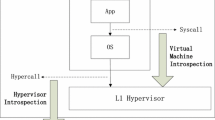Abstract
Controlled-channel attack is a novel side-channel attack that uses page faults (#PF) to infer process-sensitive information of guest-VMs. Existing protection schemes focus on restricting malicious OS of virtual machine access to page number information. They need to copy memory page content frequently or manually mark and recompile sensitive programs, which takes a lot of time and labor overhead. This paper introduces a hardware-based detection method against it in a different way. The Hypervisor monitors the modification of the guest page table entry (PTE) and the Interrupt Descriptor Table (IDT) entries to find the trace of adversary’s operations. As there is a semantic gap between VMs and Hypervisor, we take advantage of VMI (Virtual Machine Introspection) to convert important data. To overcome the challenge of changeable page tables, we grasp the feature of the target attack and filter out required records. Experiments show that this method can effectively detect controlled-channel attacks. In general, the performance overhead of the operations related to context switching will increase but within an acceptable range.
Access this chapter
Tax calculation will be finalised at checkout
Purchases are for personal use only
Similar content being viewed by others
References
Intel 64 and IA-32 Architectures Software Developer’s Manual. http://www.intel.com/content/www/us/en/processors/architectures-software-developer-manuals.html
Intel software guard extensions programming reference (rev2). https://software.intel.com/sites/default/files/managed/48/88/329298-002.pdf
SGX Tutorial. http://sgxisca.weebly.com/
UnixBench Benchmark. https://github.com/kdlucas/byte-unixbench
Baumann, A., Peinado, M., Hunt, G.: Shielding applications from an untrusted cloud with haven. ACM Trans. Comput. Syst. (TOCS) 33(3), 8 (2015)
Bellard, F.: QEMU, a fast and portable dynamic translator. In: USENIX Annual Technical Conference, FREENIX Track, vol. 41, p. 46 (2005)
Checkoway, S., Shacham, H.: Iago attacks: Why the system call API is a bad untrusted RPC interface. In: Eighteenth International Conference on Architectural Support for Programming Languages & Operating Systems, pp. 253–264 (2013)
Chen, X., et al.: Overshadow: a virtualization-based approach to retrofitting protection in commodity operating systems. ACM SIGOPS Oper. Syst. Rev. 42(2), 2–13 (2008)
Dinaburg, A., Royal, P., Sharif, M., Lee, W.: Ether: malware analysis via hardware virtualization extensions. In: Proceedings of the 15th ACM Conference on Computer and Communications Security, pp. 51–62. ACM (2008)
Grace, M., et al.: Transparent protection of commodity OS kernels using hardware virtualization. In: Jajodia, S., Zhou, J. (eds.) SecureComm 2010. LNICST, vol. 50, pp. 162–180. Springer, Heidelberg (2010). https://doi.org/10.1007/978-3-642-16161-2_10
Hofmann, O.S., Kim, S., Dunn, A.M., Lee, M.Z., Witchel, E.: InkTag: secure applications on an untrusted operating system. In: ACM SIGARCH Computer Architecture News, vol. 41, pp. 265–278. ACM (2013)
King, S.T., Chen, P.M.: SubVirt: implementing malware with virtual machines. In: IEEE Symposium on Security and Privacy, pp. 14–pp. IEEE (2006)
Kivity, A., Kamay, Y., Laor, D., Lublin, U., Liguori, A.: KVM: the Linux virtual machine monitor. In: Proceedings of the Linux symposium, vol. 1, pp. 225–230 (2007)
Maas, M., et al.: Phantom: practical oblivious computation in a secure processor. In: Proceedings of the 2013 ACM SIGSAC Conference on Computer & Communications Security, pp. 311–324. ACM (2013)
Nguyen, A.M., Schear, N., Jung, H., Godiyal, A., King, S.T., Nguyen, H.D.: MAVMM: lightweight and purpose built VMM for malware analysis. In: Annual Computer Security Applications Conference, ACSAC 2009, pp. 441–450. IEEE (2009)
Rane, A., Lin, C., Tiwari, M.: Raccoon: closing digital side-channels through obfuscated execution. In: USENIX Security Symposium, pp. 431–446 (2015)
Shih, M.W., Lee, S., Kim, T., Peinado, M.: T-SGX: eradicating controlled-channel attacks against enclave programs. In: Proceedings of the 2017 Annual Network and Distributed System Security Symposium (NDSS), San Diego, CA (2017)
Shinde, S., Chua, Z.L., Narayanan, V., Saxena, P.: Preventing page faults from telling your secrets. In: Proceedings of the 11th ACM on Asia Conference on Computer and Communications Security, pp. 317–328. ACM (2016)
Wu, R., Chen, P., Liu, P., Mao, B.: System call redirection: a practical approach to meeting real-world virtual machine introspection needs. In: 2014 44th Annual IEEE/IFIP International Conference on Dependable Systems and Networks (DSN), pp. 574–585. IEEE (2014)
Xu, Y., Cui, W., Peinado, M.: Controlled-channel attacks: deterministic side channels for untrusted operating systems. In: 2015 IEEE Symposium on Security and Privacy (SP), pp. 640–656. IEEE (2015)
Zhou, Z., Reiter, M.K., Zhang, Y.: A software approach to defeating side channels in last-level caches. In: Proceedings of the 2016 ACM SIGSAC Conference on Computer and Communications Security, pp. 871–882. ACM (2016)
Acknowledgment
This work was supported by National Natural Science Foundation of China (No. U1536204); Foundation of Science and Technology on Information Assurance Laboratory (No. 61421120301162112009).
Author information
Authors and Affiliations
Corresponding author
Editor information
Editors and Affiliations
Rights and permissions
Copyright information
© 2018 Springer Nature Switzerland AG
About this paper
Cite this paper
Qiang, C., Liu, W., Wang, L., Yu, R. (2018). Controlled Channel Attack Detection Based on Hardware Virtualization. In: Vaidya, J., Li, J. (eds) Algorithms and Architectures for Parallel Processing. ICA3PP 2018. Lecture Notes in Computer Science(), vol 11334. Springer, Cham. https://doi.org/10.1007/978-3-030-05051-1_28
Download citation
DOI: https://doi.org/10.1007/978-3-030-05051-1_28
Published:
Publisher Name: Springer, Cham
Print ISBN: 978-3-030-05050-4
Online ISBN: 978-3-030-05051-1
eBook Packages: Computer ScienceComputer Science (R0)




